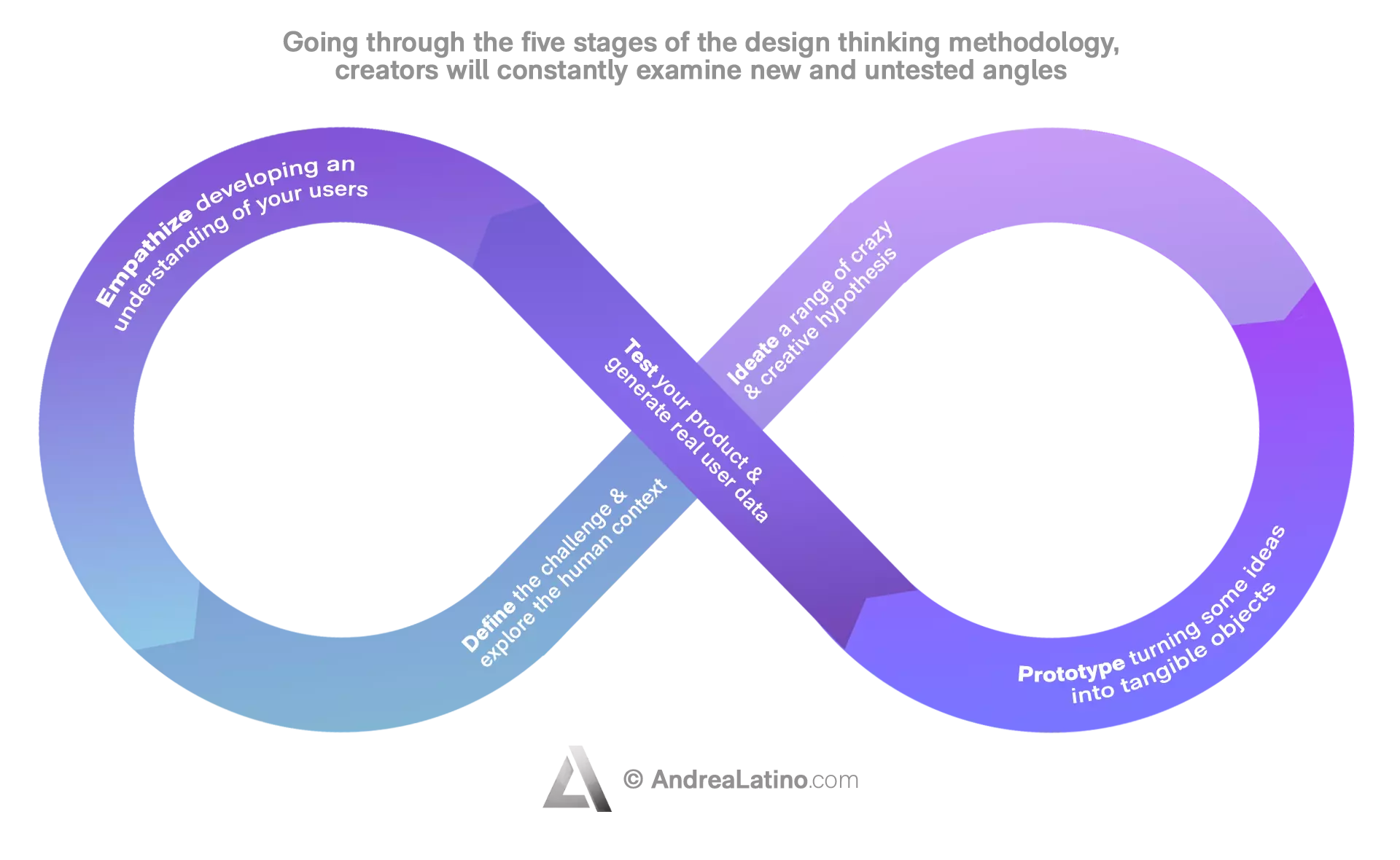Innovation Alphabet
Design Thinking
in a nutshell
Design Thinking is a methodology that can increase the chances of a company making effective decisions using creative problem solving. It is a process that allows through predefined, collaborative steps to carry out work on products and services.


Steps

Problem solving with the “human-centered” process goes through 5 stages:
Empathize: Put yourself in the customer’s shoes and understand their needs to fully comprehend the problem that needs to be solved.
Define: Analyze the information gathered to define and circumscribe the problem.
Ideate: Design a solution by unleashing the team’s creativity and recording the ideas that emerge.
Prototype: Turn ideas into prototypes to understand what might or might not work.
Test: Experiment with the chosen solution to receive feedback. The response will confirm the work done or refute it and allow the team to start again.
Application Fields
• Startup development: Startups apply the Design Thinking approach together with the Lean Startup method, which is the radical way of designing and launching an innovative enterprise. The combination of the two methodologies forms the Design Sprint, which is the main reference point regarding the action practices of startup companies.
• Product and service design: Design Thinking also concerns Sprint Execution, processes and structures for the realization and delivery of products and services made according to user needs.
• Training: The method is then handed down in staff training to teach how to creatively solve complex problems by creating a culture of innovation and fostering a cohesive and proactive environment.

Industries
• Design Thinking in the pharmaceutical industry
Mayo Clinic, a leading U.S. nonprofit organization specializing in medical practice and research, used the Design Thinking approach to create SPARC (See, Plan, Act, Refine, Communicate). This is an innovation program that uses Design Thinking principles to implement healthcare. For example, industrial engineers observe the interaction between doctors and patients and then try to give birth to ideas that will help improve efficiency.
• Design Thinking in the energy industry
Innogy, a German energy company, resorted to creative thinking to solve the problem of insufficient sales of electric cars. The team involved identified the solution as a lack of sufficient charging stations. Once the problem was defined, Innogy quickly devised an ingenious remedy, proposing the rental of e-cars through online booking.
• Design Thinking in the service industry
The U.S. company Airbnb, which specializes in short-term vacation rentals, leveraged human-centered design to revolutionize its business strategy. Design Thinking enabled the creative team to understand the real “product”: not the website or the app, but the trip. The key to achieve such a solution – and becoming, probably, the most important “interpersonal” marketplace in existence – was giving employees problems to solve instead of to-do lists.
Do you have a Operations & Human Resources challenge to tackle? Let’s face it. Together.
C-levels from these companies (AND MORE) relied on my expertise to overcome thEIR CHALLENGES IN THIS AREA. And you can, too.
Can I help you?Business Functions
• Design Thinking in support of marketing
Domino’s Pizza, an international catering company specialized in selling pizza, has implemented its marketing activities through the Design Thinking approach. Smart Track My Pizza is a tool which allows the customer to track the preparation of the order minute by minute. It is an idea that has helped to greatly increase the number of customers for the chain, which has now come to prepare more than one million pizzas every day. In the United States, one out of every eight pizzas is sold by Domino’s. Luckily, in Italy, a lot less.
• Design Thinking in support of HR
Google wanted to embed within its corporate structure a mindset based on the involvement of corporate employees. The goal? To create and nurture an organizational culture suitable for conveying confidence and a proactive attitude toward innovative processes. To implement such a project, the company adopted the famous 80/20 formula, whereby employees are encouraged to spend 80 percent of their time on key projects and 20 percent on innovation activities pertaining to their personal interests.
• Design Thinking in support of management
Uber is a company specializing in private car transportation service that uses a mobile application to connect passengers and drivers directly. It has adopted the creative thinking approach to make management more functional. With the help of Design Thinking, Uber has been able to adopt and manage new technologies that enable it to solve complex logistical challenges, thus succeeding in expanding worldwide and expanding services for society.
Stay in wonderland
Let me show you how deep the rabbit hole goes.
Check out more of the Innovation Alphabet:

3D Printing
3D Printing
“3D printing” is a process carried out by an electronic device which, instead of resorting to the canonical ink, it molds almost any kind of material: from concrete to living tissue, most usually plastic, but also metal. And the operating principle is similar to that of a traditional printer. The creation of three-dimensional models can lead to the redesign of a company’s production capabilities.
Dive In
5G
5G
5G is the new frontier of cellular telephony. It was designed to improve (or completely replace) previous generations of mobile networks. The 5th generation features lower latency, ensuring flawless performance of business applications and many other digital experiences – thus enabling the new cultural generations to furiously play Fortnite away from home.
Dive In
Advanced Analytics
Advanced Analytics
The term “Advanced Analytics” refers to the ability to autonomously or semi-autonomously analyze data and content to identify correlations, develop analyses, predictions, and recommendations. It is not just a matter of collecting information and then organizing it into watertight compartments: the ultimate goal is to identify a dialogue pattern from a data-driven perspective.
Dive In
Agile
Agile
Agile is an approach to software development designed to respond to change. Teams quickly analyze the context in which they operate, identify uncertainties faced, and figure out how to adapt to always move forward. Interaction between individuals comes before processes and tools; collaboration with the customer is more important than negotiating contracts.
Dive In
Ansoff Matrix
Ansoff Matrix
The Ansoff Matrix is a marketing planning model that arises from the intersection of new and existing products and markets. It derives four possible strategies for expanding the company’s market, which are built around four variables with a changeable factor of risks and possibilities: existing product, new product, existing market, new market.
Dive In
Artificial Intelligence
Artificial Intelligence
Artificial Intelligence is not strictly defined. Basically, it is a computer system able to make decisions in an independent and flexible way. A good AI application can perform everyday tasks better than an average person (e.g., identifying other people from their photos on social media or beating the best chess player). Nothing to fear, then. Unless you are a chess champion.
Dive In
Artificial Scarcity
Artificial Scarcity
We often tend to desire what we cannot have. Or what we are in danger of losing: Artificial Scarcity is a strategy that flaunts a limited number of items that do not correspond to actual availability. The goal is to stimulate the perception in consumers that the stock of items is about to run out and thus create a need based on the “fear of being cut off” or the intention to buy the item in order to resell it at a higher price.
Dive In
Attack Surface
Attack Surface
The term attack surface refers to the part of a system that may be subject to attack or breach by hackers. The smaller that surface is, the easier it will be to protect it. Indeed, the Internet is an ocean of deep, dark waters: those who navigate it must be aware that they are exposing themselves to a flood of digital risks. Yet, ironically, we do not need a big boat to shelter us.
Dive In
Augmented Reality
Augmented Reality
Augmented Reality is an ever-evolving technology that overlays multimedia information on top of our common sensory horizon to gain a deeper understanding of our surroundings. No, it doesn’t allow you to step out of the Matrix dream simulation, nor can it be accessed by swallowing a red pill. But neither is it the disturbing experience of the Playtest episode of Black Mirror.
Dive In
Balanced Scorecard
Balanced Scorecard
In business, as in life, you need balance. The Balanced Scorecard is a holistic tool for strategic management. It offers, in fact, the possibility of assessing corporate performance in its wholeness. An overview that embraces four perspectives: the business/financial side, customers and stakeholders, internal processes, and learning and growth.
Dive In